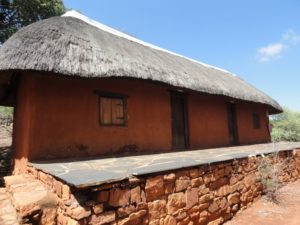Boekenhoutfontein

BRONKHORST HOUSE
Built in the 1840’s by Rudolph Bronkhorst, the first owner of Boekenhoutfontein, the house is typical of the early Transvaal pioneer type. The walls are made of sun-dried mud bricks, which were simply plastered over with clay, and not painted. Wood for the roof beams, window and door frames and window shutters was cut from the locally occurring Boekenhout (Beechwood) trees. There were no window panes, because at this time window glass was unavailable in the Transvaal. The house was occupied at least until 1862, when Paul Kruger purchased the farm and built the first Kruger house.

FIRST KRUGER HOUSE
Built by Paul Kruger in 1862, it is a traditional Transvaal Boer farmhouse, with thick white-washed walls, a high reed ceiling and a thatched roof. These construction methods made for a dwelling that would be cool in summer and warm in winter. It has a peach-pip and cow-dung floor, which was extremely durable. Paul Kruger and his family stayed here from 1862 until 1873, when the second house was constructed. Today, it is used as a museum which contains exhibits informing visitors about daily life on a 19th century Transvaal farm.

SECOND KRUGER HOUSE
Built by Paul Kruger in 1873, this double-storey house with its flat roof is extremely unusual for the Transvaal. It is in fact typical of the style found in the Colesberg district of the Cape Colony, where Kruger had lived until the age of 10. However, the construction methods are typical of those used in the Rustenburg district. The timber is Boekenhout (Beechwood), and the house has a traditional cowdung and blood floor. Traces of the original wallpaper were found, as was the blue paint on the bedroom walls, and these were carefully replicated during restoration. Kruger resided here with his large family until 1883 when he became President and moved to Pretoria. After this, he continued to visit Boekenhoutfontein regularly until he left South Africa in 1900.

PIETER KRUGER HOUSE
Built in the 1890’s by Pieter Kruger, one of the sons of Paul Kruger. It is typical of the Transvaal farmhouses of the late Victorian period, with its pitched corrugated iron roof, wooden floors, and decorative balustrade around the front veranda. Pieter Kruger lived here with his wife Cecilia and their twelve children. In 1900, during the South African War, the family moved away from the farm. Pieter Kruger was captured on 30 July 1900 at Ficksburg while on commando, and was sent to the Diyatalawa prisoner-of-war camp in Ceylon (now Sri Lanka). Pieter and Cecilia returned to this house when the war ended in 1902, and lived here until their deaths (Pieter in 1911, and Cecilia in 1921).

THE OLD SCHOOLROOM
Built about 1890, probably by Pieter Kruger, one of the sons of Paul Kruger. It is a simple rectangular structure, constructed with sun-dried mud bricks, and a clay and cowdung floor. There is a pitched corrugated iron roof, and it is noticeable that some of the sheets of corrugated iron have been flattened. According to Kruger family sources, allowance was not made for the overlap between the sheets, and thus not enough corrugated iron was ordered. The problem was solved by having some of the sheets flattened. The building served as a school from about 1892 to 1915, and was subsequently used as a storeroom, stable and garage.
For more detailed information on Kruger and Boekenhoutfontein, take a look at the following articles:
“To Make Them Serve“: The 1871 Transvaal Commission on African Labour as a Source for Agrarian History
Johan S. Bergh
History in Africa, Vol. 29 (2002), pp. 39-61
Cambridge University Press
S.J.P. Kruger in the Dock, 1872
Johan Bergh
To cite this article: Johan Bergh (2011) S.J.P. Kruger in the Dock, 1872, South African Historical
Journal, 63:1, 1-19, DOI: 10.1080/02582473.2011.549370
“We Must Never Forget Where We Come from“: The Bafokeng and Their Land in the 19thCentury Transvaal
J. S. Bergh
History in Africa, Vol. 32 (2005), pp. 95-115
Cambridge University Press
Slave-Raiding and Slavery in the Western Transvaal after the Sand River Convention
Fred Morton
African Economic History, No. 20 (1992), pp. 99-118
University of Wisconsin Press
S.J.P. Kruger and landownership in the Transvaal
J.S. Bergh
Historia 59, 2, November 2014, pp 69-78
Die Kruger-huis op Boekenhoudfontein NR 336 Distrik Rustenburg.
H.M. Rex.
Historia 1. 1956